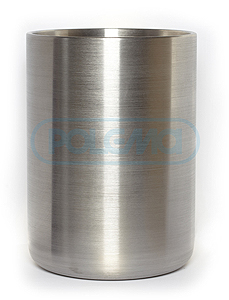
Tungsten crucibles
Tungsten crucibles
Use
Tungsten crucibles, thanks to their resistance to certain molten metals and metal oxides, have found wide use in technologies for growing monocrystals from molten corundum, as well as in electronics and technologies for thermal vaporization and deposition of various substances.
Chemical composition
| Brand | W, % minimum | Admixtures, ppm, maximum | ||||||||
| Crucible W-PM | 99,0 | Fe | Ni | Al | Mo | Si | K | Na | Ca | As |
| 80 | 50 | 10 | 400 | 30 | 200 | 150 | 50 | 50 | ||
Upon agreement with the client, crucibles can be prepared with additions of molybdenum of up to 0.9%, and with other requirements regarding the material's chemical composition.
Shapes, dimensions and surface condition of W-PM crucibles

Crucibles are made in accordance with plans. The shape and dimensions are agreed upon with the client. The surface roughness of tooled crucibles does not exceed Rz 6.3.
Sample dimensions of sintered tungsten crucibles W-PM, diameter Ø х height, mm:
- Ø130х150;
- Ø200х240;
- Ø240х300;
- Ø250х350-400;
- Ø330х350;
- Ø330х450;
- Ø338х460.
Modestly sized crucibles made form forged tungsten —for example, with diameters of 40-50mm—can be produced based on plans agreed to with the client.
Crucible density:
- Sintered crucibles W-PM – at least 17.8 g/cm3;
Advantages:
- the products' fairly high chemical purity, which ensures sapphire monocrystals free from impurities;
- a fairly wide selection of standard product sizes, to quickly fulfill consumers' order;
- the ability to develop products with new sizes based on the client's individual needs.
Recommendations on using and storing crucibles.
Before use, it is recommended that the consumer anneal (de-gas) crucibles in a vacuum without batch charging.
In a furnace, the annealment process should be supported with a vacuum at Р < 10-4 mmhg
Heating and cooling technique:
- raise temperature (Т) to 1000 оС over a period of 3 hrs;
- hold at Т=1000 оС for at least 1 hr;
- raise to Т=1400-1500 оС for at least 1 hr;
- hold at Т=1400-1500 оС for at least 1 hr;
- raise to Т=2000-2200 оС for at least 1 hr;
- hold at Т=2000-2200 оС for at least 1 hr;
- cool crucibles in furnace.
When preparing a crucible for work, the consumer should not allow a sharp rise or fall in temperature, or abbreviate the recommended time periods for holding temperatures.
While preparing the crucible for work, and during operation, it should not be subjected to shocks.
The manufacturer packs crucibles into wooden packaging (crates) with crash pads. During transport and storage, the crucibles are not submitted to sharp jolts or shocks. They are stored in the manufacturer's packaging in closed warehouses under conditions set forth by the group 1 (L) of the State Standard 15150.